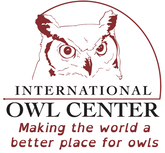|
Originally posted Monday, 10 March 2014 09:53
I updated the website a while back and intended to do a live chat session specifically about the topic of the 2014 owlets, but time slipped away from me as I was working on the International Festival of Owls plans and I just plain needed some down time. The 2014 owlets will be raised different from how Pandora, Patrick, and Patience were reared last year. This year's owlets will be hand-reared to compare their vocal development with wild parent-reared owlets (the 3 P's) to see if it is the same or different. It will also allow me to test theories about the meaning of vocalizations by testing the owlets' repsonse to recorded vocalizations. I will remove the owlets from the aviaries when they are 2-3 weeks old. They will be reared together in the house, coming to work with me at the Houston Nature Center during the daytime. I will be working on another more portable cam setup so they can be streamed live from home and work (although we may not include audio at work, and will likely only stream them at home after we have gone to bed for privacy reasons.) Once the owlets are starting to fly they will be moved back into the flight pen so they can be watched on the cams out there again. We will modify the flight pen to lower the ceiling and make their space smaller so that I am able to get them off perches to continue to bring them to work so they can begin their training for their eventual placement as education birds. Placing the owlets in long-term captive situations as education birds will allow me to track their territorial hoots over their lifetime to see if they stay the same or change. The value is that if their territorial hoots remain constant, and we can show that individual hoots work like fingerprints to identify individual owls, birds may not need to be captured and marked in future research projects, reducing stress on birds and eliminating the problem of failed batteries in transmitters. I have chosen this rearing method because I believe it will produce the best possible education birds, meaning they will be very comfortable with their role in life, and they will be easy for handlers to work with. They should imprint on each other rather than humans, so they should be less likely to be aggressive with their handlers than human imprinted birds. They will be well socialized with humans so they are not stressed being in front of crowds. Rusty and Iris will certainly not be happy about their owlets being removed, just as they were upset when I removed their unhatched eggs two years ago. There is a small chance they may lay another clutch of eggs, but it is likely a little too late in the season for that. What we find out from these owlets this year will help determine the best course of action for future data collection in this breeding project and determine how future owlets are reared.
1 Comment
|
AuthorKarla Bloem is the Executive Director of the International Owl Center. ArchivesCategories
All
|
|
Links - Privacy policy
International Owl Center
126 E Cedar St. Houston, MN 55943 (507) 896-OWLS (6957) [email protected] 501(c)(3) organization EIN #45-5503365 |
|
|

 RSS Feed
RSS Feed




